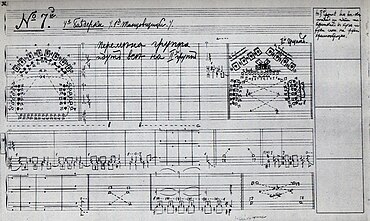195:
downturns can be written in terms of numbers, putting the different numbers of turns in the same order and pattern the dancer executes them. For example, if the numbers 1, 2, and 3 were written in a straight line, then the dancer would similarly turn three times in a straight line. As another example, if the numbers 0, 1, 2, 3, 4, and 5 are written in a circle, with 0 at the top and the numbers in increasing order clockwise around the circle, the dancer does 5 turns while walking in a clockwise circle. With
Stepanov notation, arm movements are written as symbols similar in appearance to music notes with streaks around them. The streaks indicate how the dancer is supposed to move his/her arms and the notes indicate on which beat each arm movement is to occur. A space on the paper specifies the audience's location.
98:
181:
33:
212:
Stepanov notation encounters difficulty in describing body direction as it utilizes a system of relative "greater than" and "less than" positions relative to the current facing of the dancer, requiring them to memorize the meanings of these terms in relation to every position in the dance. Some might
194:
In his publication of
Stepanov's method, Alexander Gorsky stated: “Poses or Movement lasting two units of time we notate with signs called halves (½) as they are made up of two quarters. Poses or movements lasting four units are notated with two half notes connected by arches.” In Stepanov notation,
164:. After taking an anatomy course, he continued his studies in Paris. Once it was adopted by the St. Petersburg school, Stepanov was given the title Instructor in Movement Analysis and Notation; however, he died at age 29. The system continued to develop following his death.
203:
Stepanov’s system does not require the study of many symbols to understand it. This system makes it possible to show more than a single movement at a time. Overall, it has been claimed to be a good approach to describing body movement.
136:
instead of pictographs or abstract symbols. Stepanov breaks complex movements down to elementary moves made by individual body parts, enciphering these basic moves as notes. This method of dance notation, improved by
171:
in
Stepanov notation. This publication was a slightly enhanced version of Stepanov's original work. Many other variations of Stepanov notation were made following this, such as Conte notation and Nicholas notation.
97:
267:
213:
also call the translation from some manuscripts for ballet steps crude due to the difficulty of translating an anatomical movement onto the paper.
62:
17:
156:
Stepanov wrote his book from an anatomical perspective. The movements were written in terms of joints of the body, along with
272:
84:
55:
226:: A Comparison of Dance Notation Systems from the 15th century to the present. London : Routledge, 2014.
180:
45:
49:
41:
262:
257:
66:
282:
277:
8:
150:
146:
109:
138:
113:
121:
241:
186:
251:
142:
233:(Translated from Russian into English by Roland John Wiley). New York 1978.
133:
223:
132:
in 1892. The book describes a notation that encodes dance movements using
161:
157:
129:
167:After Stepanov's death, Alexander Gorsky printed
249:
184:An example of Stepanov-notated choreography for
54:but its sources remain unclear because it lacks
149:Library Theatre Collection and is known as the
126:L'Alphabet des Mouvements du Corps Humain) was
268:Male ballet dancers from the Russian Empire
118:The Alphabet of Movements of the Human Body
141:, notated many ballets from choreographer
145:. Today, this method is preserved in the
85:Learn how and when to remove this message
240:(Translated from French into English by
179:
96:
238:Alphabet of Movements of the Human Body
14:
250:
160:, extension, rotation, direction, and
231:Two Essays on Stepanov Dance Notation
175:
26:
24:
25:
294:
108:(1866–1896), was a dancer at the
207:
31:
236:Stepanov, Vladimir Ivanovich.
13:
1:
216:
198:
7:
106:Vladimir Ivanovich Stepanov
18:Vladimir Ivanovich Stepanov
10:
299:
273:Mariinsky Ballet dancers
244:, 1892). Cambridge 1958.
40:This article includes a
222:Guest, Ann Hutchinson.
69:more precise citations.
191:
102:
183:
100:
229:Gorsky, Alexander.
151:Sergeyev Collection
192:
147:Harvard University
103:
42:list of references
176:Stepanov notation
110:Mariinsky Theater
101:Vladímir Stepànov
95:
94:
87:
16:(Redirected from
290:
139:Alexander Gorsky
114:Saint Petersburg
90:
83:
79:
76:
70:
65:this article by
56:inline citations
35:
34:
27:
21:
298:
297:
293:
292:
291:
289:
288:
287:
248:
247:
219:
210:
201:
178:
91:
80:
74:
71:
60:
46:related reading
36:
32:
23:
22:
15:
12:
11:
5:
296:
286:
285:
280:
275:
270:
265:
263:Dance notators
260:
258:Russian ballet
246:
245:
242:Raymond Lister
234:
227:
224:Choreographics
218:
215:
209:
206:
200:
197:
177:
174:
169:Table of Signs
93:
92:
50:external links
39:
37:
30:
9:
6:
4:
3:
2:
295:
284:
281:
279:
276:
274:
271:
269:
266:
264:
261:
259:
256:
255:
253:
243:
239:
235:
232:
228:
225:
221:
220:
214:
208:Disadvantages
205:
196:
189:
188:
182:
173:
170:
165:
163:
159:
154:
152:
148:
144:
143:Marius Petipa
140:
135:
134:musical notes
131:
128:published in
127:
123:
119:
115:
111:
107:
99:
89:
86:
78:
68:
64:
58:
57:
51:
47:
43:
38:
29:
28:
19:
237:
230:
211:
202:
193:
190:, circa 1900
185:
168:
166:
155:
125:
117:
116:. His book,
105:
104:
81:
72:
61:Please help
53:
283:1896 deaths
278:1866 births
187:La Bayadère
67:introducing
252:Categories
217:References
199:Advantages
75:March 2017
162:adduction
158:flexion
63:improve
122:French
130:Paris
48:, or
112:in
254::
153:.
124::
52:,
44:,
120:(
88:)
82:(
77:)
73:(
59:.
20:)
Text is available under the Creative Commons Attribution-ShareAlike License. Additional terms may apply.

